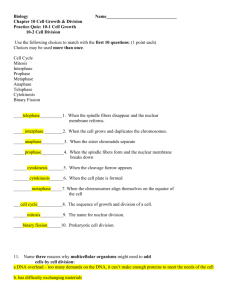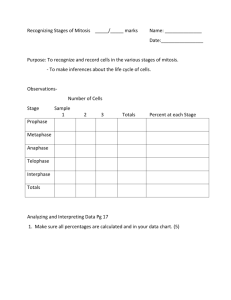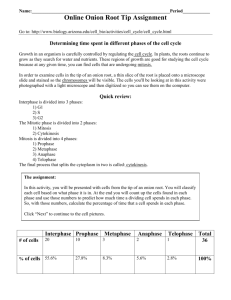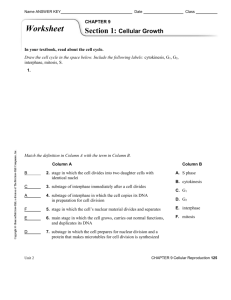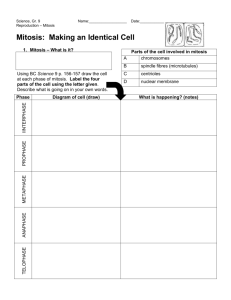Mitosis - SnapPages
advertisement
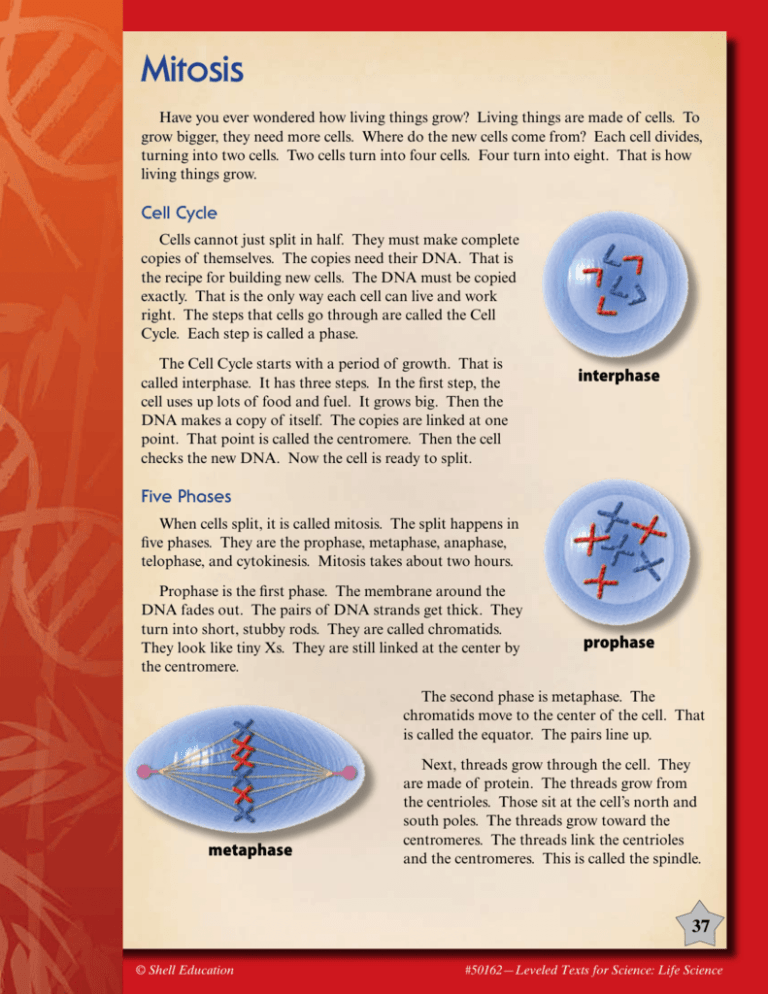
Mitosis Have you ever wondered how living things grow? Living things are made of cells. To grow bigger, they need more cells. Where do the new cells come from? Each cell divides, turning into two cells. Two cells turn into four cells. Four turn into eight. That is how living things grow. Cell Cycle Cells cannot just split in half. They must make complete copies of themselves. The copies need their DNA. That is the recipe for building new cells. The DNA must be copied exactly. That is the only way each cell can live and work right. The steps that cells go through are called the Cell Cycle. Each step is called a phase. The Cell Cycle starts with a period of growth. That is called interphase. It has three steps. In the first step, the cell uses up lots of food and fuel. It grows big. Then the DNA makes a copy of itself. The copies are linked at one point. That point is called the centromere. Then the cell checks the new DNA. Now the cell is ready to split. interphase Five Phases When cells split, it is called mitosis. The split happens in five phases. They are the prophase, metaphase, anaphase, telophase, and cytokinesis. Mitosis takes about two hours. Prophase is the first phase. The membrane around the DNA fades out. The pairs of DNA strands get thick. They turn into short, stubby rods. They are called chromatids. They look like tiny Xs. They are still linked at the center by the centromere. prophase The second phase is metaphase. The chromatids move to the center of the cell. That is called the equator. The pairs line up. metaphase Next, threads grow through the cell. They are made of protein. The threads grow from the centrioles. Those sit at the cell’s north and south poles. The threads grow toward the centromeres. The threads link the centrioles and the centromeres. This is called the spindle. 37 © Shell Education #50162—Leveled Texts for Science: Life Science Anaphase is the third phase. The spindle gets long. This makes the cell longer, too. The threads pull the chromatids. They pull toward the poles. The poles collect matching sets. On each end is a complete set. They both have the same genetic recipe. Mitosis is nearly done. Telophase is the fourth phase. The sets get to the north and south poles of the cell. They begin to form new nuclei. A membrane forms around them. The spindle threads fade out. A dent forms down the center of the cell. anaphase Cytokinesis is the final phase. The dent pinches the cell in half. Now there are two cells. Mitosis is complete. Now the cell goes back to interphase. It will work and grow. It gets ready to do it all over again. telophase cytokinesis Comprehension Question What are the five phases of mitosis? 38 #50162—Leveled Texts for Science: Life Science © Shell Education Mitosis Have you ever wondered how living things grow? Living things are made of cells. To grow bigger, they need more cells. Where do the new cells come from? Each cell divides, turning into two cells. Two cells turn into four cells, and four into eight. That is how living things grow. Cell Cycle Cells cannot just split in half. They create complete copies of themselves. The copies include their DNA, the recipe for building new cells. The DNA must be copied exactly. That is the only way each cell can survive and work properly. The steps that cells go through are called the Cell Cycle. Each step is called a phase. The Cell Cycle starts with a period of growth called interphase. It has three steps. In the first step, the cell processes all the materials it needs to grow stronger. Then the DNA makes a copy of itself. These DNA copies are joined at one point. That point is called the centromere. Interphase ends as the cell checks to see if the new DNA is in order. Now the cell is ready to divide. interphase Five Phases Cell division is called mitosis. It occurs in five phases. They are the prophase, metaphase, anaphase, telophase, and cytokinesis. Mitosis takes about two hours to complete. Prophase is the first phase of mitosis. The cell’s nuclear membrane fades out. The pairs of DNA strands prophase thicken. They become short, stubby rods. They are called chromatids. They look like tiny Xs. They are still linked at the center by the centromere. The second phase is metaphase. The chromosome pairs move to the center of the cell. That is called the equator. The pairs line up. metaphase Next, protein threads grow through the cell. The threads grow from the centrioles. Those sit at the cell’s north and south poles. The threads grow toward the centromeres. The threads connect the centrioles and the centromeres. This new connection is called the spindle. 39 © Shell Education #50162—Leveled Texts for Science: Life Science Anaphase is the third phase of mitosis. The spindle lengthens. This makes the cell longer, too. The threads pull the chromosomes toward the poles. Each pole collects an identical set. On each end is a complete set of the same genetic recipe. Mitosis is nearly done. Telophase is the fourth phase. The sets finally arrive at the north and south poles of the cell. They begin to organize into new nuclei. A membrane forms around them. The spindle fibers fade out. A dent begins to form down the center of the cell. anaphase Cytokinesis is the final phase. The dent pinches the cell in half. Now there are two daughter cells. Mitosis is complete. Now the cell goes back to interphase. It will work and grow. It will get ready to go through the cell cycle all over again. telophase cytokinesis Comprehension Question Describe what happens in each of the five phases of mitosis. 40 #50162—Leveled Texts for Science: Life Science © Shell Education Mitosis Have you ever wondered how living things grow? Living things are made of cells. To grow bigger, they need more cells. Where do the new cells come from? Each cell divides, turning into two cells. Two cells turn into four cells, and four into eight. That is how living things grow. Cell Cycle Cells cannot just split in half. They create complete copies of themselves. The copies include their DNA, the recipe for building new cells. The DNA must be copied exactly. That is the only way each cell can survive and work properly. The steps that cells go through are called the Cell Cycle. Each step is called a phase. The Cell Cycle starts with a period of growth called interphase, which occurs in three steps. In the first step, the cell processes all the materials it needs to grow stronger. Then the DNA makes a copy of itself. These DNA copies are linked at a point called the centromere. Interphase ends as the cell checks to be sure the newly copied DNA is in order. Now the cell is ready to divide. interphase Five Phases Cell division, or mitosis, occurs in five phases. They are the prophase, metaphase, anaphase, telophase, and cytokinesis. Mitosis takes about two hours to complete. Prophase is the first phase of mitosis. The cell’s nuclear prophase membrane disappears, and the strands of DNA that paired off during interphase thicken. They become short, stubby rods called chromatids. The stubby rods look like tiny Xs. They are attached at the center by the centromere. The second phase of mitosis is metaphase. The chromosome pairs move to the center, or equator, of the cell. The pairs line up across the equator. metaphase Next, the protein threads grow toward the centromeres in the chromosomes. The threads grow from the centrioles, which sit at the cell’s north and south poles. The threads connect the centrioles and the centromeres. This new connection is called the spindle. 41 © Shell Education #50162—Leveled Texts for Science: Life Science Anaphase is the third phase of mitosis. The spindle lengthens. This makes the cell longer, too. The threads pull the chromosomes toward the poles. Identical sets of chromosomes move toward the poles. Each pole now contains a complete set of chromosomes. When the cell divides, each cell will contain a complete set of the same genetic recipe. Mitosis is nearly complete. Telophase is the fourth phase. During telophase, the chromosomes finally arrive at the north and south poles of the cell. They begin to organize themselves into new nuclei. A membrane forms around each new nucleus. The spindle fibers disappear. A dent or furrow begins to form down the center of the cell. anaphase Cytokinesis is the final phase of mitosis. The dent pinches the cell into two daughter cells. Mitosis is complete. Now the cell returns to interphase. It will process materials and get ready to go through the cell cycle all over again. telophase cytokinesis Comprehension Question Describe the five phases of mitosis. 42 #50162—Leveled Texts for Science: Life Science © Shell Education Mitosis Have you ever wondered how organisms grow? Since organisms are made of cells, growing larger requires the creation of new cells. Where do the new cells come from? Each cell divides, turning into two cells, two cells into four cells, and four into eight. Cell Cycle Cells cannot simply split in half; they must create complete copies of themselves. The copies must include exact copies of their DNA, a molecule that has instructions for cell operation and replication. A perfect copy of DNA is necessary for the cell to survive and function properly. The steps, or phases, that cells go through are called the Cell Cycle. The Cell Cycle starts with a period of growth called interphase, which occurs in three steps. In the first step, the cell processes all the materials it needs to increase its size. Then the DNA makes a copy of itself, and links the copy to the original at a point called the centromere. Interphase ends as the cell checks to be sure the newly copied DNA is in order. interphase Five Phases Cell division, or mitosis, occurs in five phases. They are the prophase, metaphase, anaphase, telophase, and cytokinesis. Mitosis takes about two hours to complete. Prophase, the first phase of mitosis, occurs when the prophase cell’s nuclear membrane disappears and the strands of DNA that paired off during interphase thicken. They become short, stubby rods in “X”shapes called chromatids. They are attached at the center by the centromere. The second phase of mitosis is metaphase. The chromosome pairs move to the cell’s equator and line up along it. metaphase Next, protein threads grow towards the chromosomes’ centromeres. The threads grow from centrioles at the cell’s north and south poles. The threads connect the centrioles and the centromeres in a structure called the spindle. 43 © Shell Education #50162—Leveled Texts for Science: Life Science Anaphase is the third phase of mitosis. The spindle lengthens, making the cell longer. The threads pull the chromosomes toward the centrioles. Identical sets of chromosomes move toward the poles until each pole contains a complete set of chromosomes. When the cell divides, each cell will contain a complete set of the same genetic recipe. During the fourth phase, telophase, the chromosomes finally arrive at the north and south poles of the cell. They begin to organize themselves into new nuclei while a membrane forms around them. The spindle fibers disappear and a dent or furrow begins to form down the center of the cell. anaphase Cytokinesis is the final phase of mitosis. The dent pinches the cell into two daughter cells. Mitosis is complete. Now the cell returns to interphase. It will process materials and get ready to go through the cell cycle all over again. telophase cytokinesis Comprehension Question Summarize the process of mitosis. 44 #50162—Leveled Texts for Science: Life Science © Shell Education




